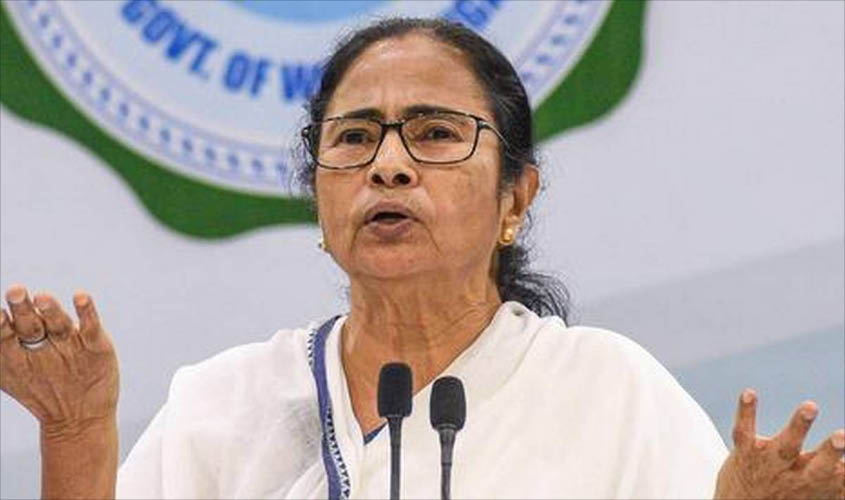West Bengal Chief Minister Mamata Banerjee continues to be a thorn in the BJP’s flesh, and could prove to be the most difficult obstacle in the Assembly elections next year for the saffron brigade to cross. In fact, she is probably the only one who can stop the BJP’s march into Bengal, thus preventing the Sangh Parivar from scoring any major victory.
Mamata, who ended the 34-year Leftist rule in one of the most politically vibrant states of the country, is also perhaps the only one who can counter both Prime Minister Narendra Modi and Amit Shah, in a real showdown in the electoral arena. The BJP’s greatest handicap as of now is, that it does not have a credible face to project as the Chief Ministerial candidate; this could turn out to be a major factor in upsetting any kind of calculations.
There are many analysts who believe that the BJP can never humble the Congress in a political contest and it is Congressmen alone who can undo their party. Therefore, the saffron strategy so far in most the states has been to wean away prominent Congressmen and use them to neutralize their erstwhile colleagues.
This Vibheeshan formula has been successful in Assam where Himanta Biswa Sarma prepared the blueprint for the Congress defeat. It assisted the BJP in Haryana, where both Chaudhury Birendra Singh and Rao Inderjit played a stellar role in dismantling the Congress challenge. In Uttarakhand it was Vijay Bahuguna, Yashpal Arya and Harak Singh Rawat and in Uttar Pradesh, Jagdambika Pal and Rita Bahuguna Joshi did contribute to the Congress rout. More recently, Jyotiraditya Scindia was instrumental in the fall of the Kamal Nath government, and Sachin Pilot almost did a repeat show in Rajasthan.
In Bengal, the BJP has been able to take away Mukul Roy from the Trinamool Congress, which after 1998, represents what Congress was prior to that. Now, efforts are being made to induct Suvendu Adhikari, who is so far doing a flip-flop, knowing fully well that in the East Midnapore district from where he hails, there is a sizable Muslim vote percentage. He has till now not spoken a word against Mamata and is probably seeking some sort of assurance of an office from the BJP, before he makes his final move.
On her part, the Chief Minister would want him to leave as early as possible, since she has already consolidated her party’s position, and would shortly be assigning some others to look after that region. However, BJP’s desperation to make deep forays into the rural belt does not appear to be succeeding, and it is likely that as in Bihar, the saffron brigade may expect that Asaduddin Owaisi and his party, would corner sizable Muslim votes and thus influence the outcome of the elections.
What needs to be understood is that Mamata has done her political apprenticeship under the veterans of Chhatra Parishad, who fought street battles with the Leftists, to keep the Congress alive in the state. She continues to be advised by Subroto Mukherjee and Saugata Roy amongst others. As the legend has it that during the peak of the JP movement, she had climbed on to the hood of the Lok Nayak’s car to register her strong protest. She was also a part of the Youth Congress when it was potent force, and politically evolved during that stint.
Mamata first shot into national limelight in 1984, when to make her Parliamentary debut, she defeated Somnath Chatterjee, the right-hand man of then Chief Minister, Jyoti Basu and a very accomplished politician in his own right. In fact, for Somnath, who subsequently rose to become the Lok Sabha Speaker, this was the only defeat he suffered in his career, which began in 1971 and helped him to win 10 Lok Sabha elections. The outcome stunned most political observers, and a similar feat was repeated when Bhupinder Singh Hooda defeated Chaudhury Devi Lal from Rohtak, many years later.
The short point is that unlike the current Congress leadership, Mamata is a 24X7 politician, and is not overawed by the strengths of her opponents. She sizes them up and fights in an aggressive manner wherever she can, stopping them from making inroads. She does not have to face the dilemma of the Congress, which has no clue how to get the better of the BJP’s cadre and money power, or its understanding of how modern electoral battles are fought. She has the wherewithal to combat her rivals.
The paradoxical thing about Bengal is that while the caste system there is very pronounced, it has not been a factor in the elections so far. Outside her own state, Mamata is viewed as the only Brahmin mass leader in the country, whose appeal transcends political parties. Many in the Congress view her as their own and would want her to head the party at some stage, in order to revive the dying organisation. The BJP has made futile attempts to paint her as a pro-Muslim politician, but this has not stopped her from pursuing her political agenda.
In 1980, when there was reconciliation between the late Sanjay Gandhi and the Rashtriya Swayamsevak Sangh, the meeting ground was not what the Parivar perceived as his anti-Islamic slant, but his contempt for the communists. This was the underlying principle. Mamata is also not a communalist but a hard-core anti-Leftist. This is where she stands. Between us.
Mamata Banerjee, BJP’s final hurdle
- Advertisement -

